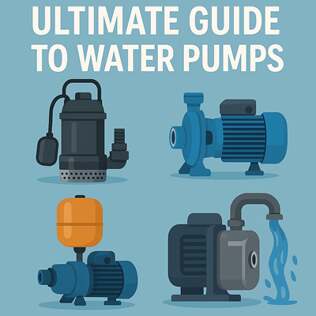Well Pumps: Deep vs. Shallow Well Pumps, Selection, Cost & Troubleshooting
Deep vs. shallow, in plain English
A shallow well pump is normally used when the static water level is about 25 feet or less from the surface. These pumps sit above ground and rely on suction to lift water. A deep well pump, usually a submersible type, is designed for depths well below that threshold and is installed inside the well column to push water up. The 25 foot rule is a common industry cutoff because suction becomes unreliable beyond that depth.
How the main pump types differ
- Submersible pump: Sits submerged in the well, uses centrifugal action to push water up; efficient for deep wells and high flow needs.
- Jet (shallow or deep) pump: Mounted above ground; a shallow jet has a single suction line, while a deep jet uses a two pipe ejector assembly down in the well. Jet pumps “pull” water, which limits how deep they can work.
- Booster pump / pressure booster: Adds pressure to an existing system (for irrigation or low pressure homes).
- Specialty options: solar water pump systems for off grid use, hand pumps for very simple needs, or constant pressure (variable speed) systems for comfortable, steady delivery.
If you are weighing energy use and reliability, submersible pumps generally outperform jet pumps for the same head and flow; jet pumps are easier to service but often less efficient.
How to choose the right pump (practical checklist)
Think of this as an interview your property gives you; answer these questions and you’ll know what to buy:
- Well depth and static water level, absolute dealbreakers for pump type.
- Required flow (GPM) based on household demand: sprinklers, showers, appliances.
- Required pressure and whether you want constant pressure; note typical settings like
30/50 psior20/40 psi. - Electrical supply: single phase vs three phase, and whether 12V/solar is needed.
- Budget and life cycle cost: cheaper pumps cost less now but may run hotter and use more electricity.
- Maintenance access: above ground jet pumps are easier to service; submersibles require pulling the column.
- Future plans like adding a booster pump, irrigation, or a water pressure tank.
Reliable buyers’ guidance groups and pump sellers lay the same emphasis on depth, GPM and power when recommending a model.
Cost: what to expect
Expect a fairly wide range, because well work varies dramatically by depth, access, and local labor:
- Pump unit alone: small shallow pumps or basic submersibles can be a few hundred dollars; higher capacity submersibles and stainless steel models cost more.
- Installed replacement: many homeowners report totals roughly $900 to $2,500, while larger or deeper jobs commonly land between $2,500 and $4,000 once labor, new pipe, electrical and hauling are included. Some complex installs can exceed these figures. Plan for site specific variables like well casing size, wiring, and required testing.
Quick troubleshooting you can do right now
Most “no water” or “low water” calls boil down to a few recurring culprits. Try these checks in this order, before you call in heavy equipment:
- Confirm power: breaker, fused switch near the pressure tank, and any visible wiring for obvious trips or burns.
- Listen to the pump: humming without turning usually means a seized motor, capacitor problem, or electrical fault. If it clicks on and off fast, that’s short cycling.
- Check the pressure tank: if the tank is waterlogged or the bladder has failed, the pump will short cycle and overheat. You can suss out the tank by tapping it (a hollow sound means cushion of air; dull and heavy means full of water) and by checking the tank air charge with a tire gauge at the Schrader valve; adjust only when the system is off and tank drained to the pump off pressure. Typical guidance on short cycling and bladder failure is well documented.
- Inspect the pressure switch and settings: corrosion, debris, or a stuck contact will prevent proper on/off control; cleaning or replacing the switch is a common fix.
- Low flow but pump runs: check for clogged intake screens, a failed foot valve, or a failing impeller; reduced amperage draw can indicate internal wear.
- No water and pump not drawing amps: wiring or motor failure is likely; at this point call a professional to avoid electrocution or damaging the pump.
If you are not comfortable with electrical work, or if the pump is submersible and must be pulled, contact a licensed well contractor.
When to replace rather than repair
Repair when the problem is simple: a pressure switch, bladder, or check valve. Replace when the motor has failed, repair costs approach replacement cost, or the pump is old and inefficient. Upgrading to a properly sized submersible can reduce energy use and improve reliability for homes with high demand. Industry guides and installer quotes will help you decide if the numbers justify replacement. #wellpump #submersiblepump #waterpumps

